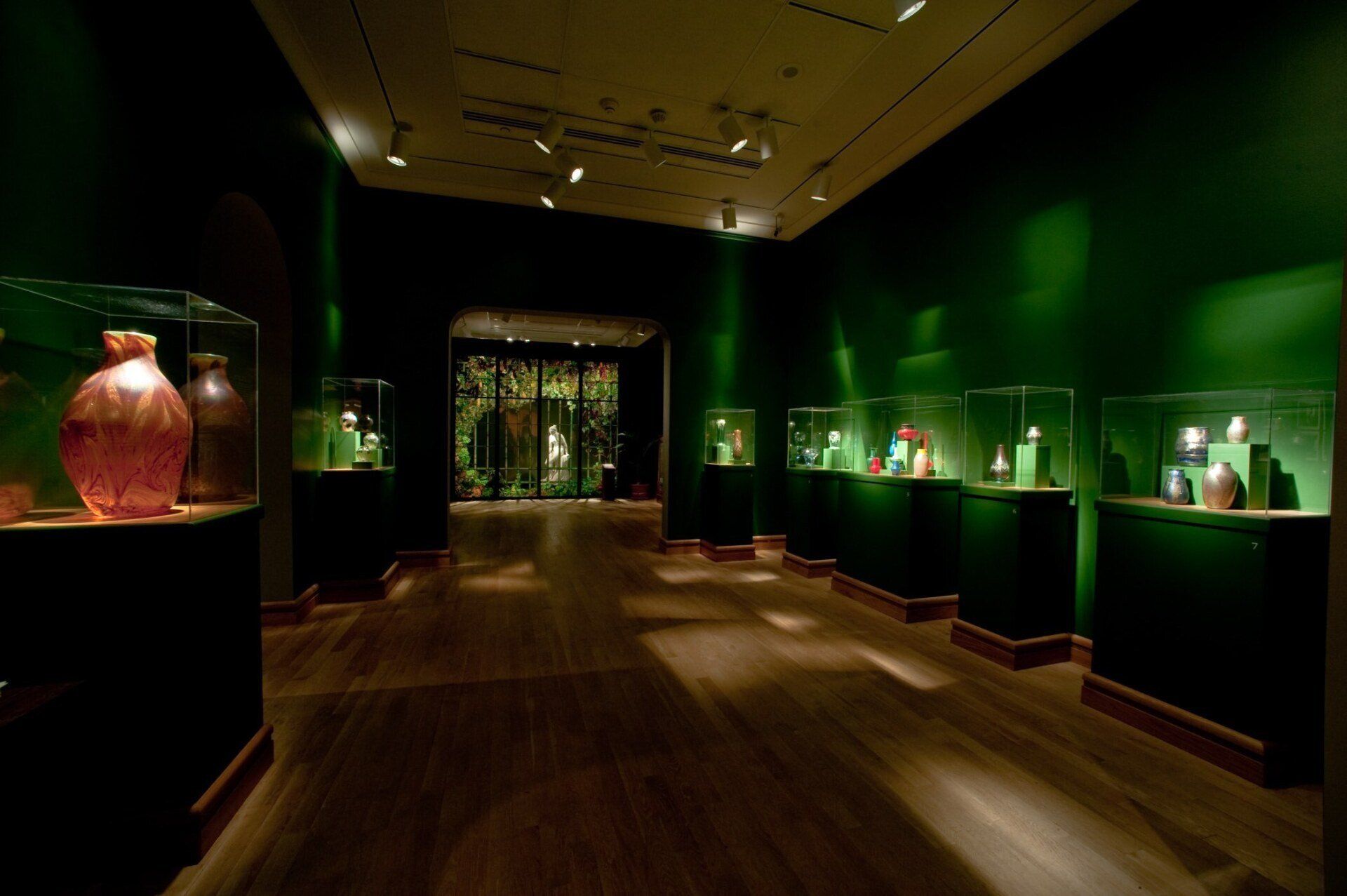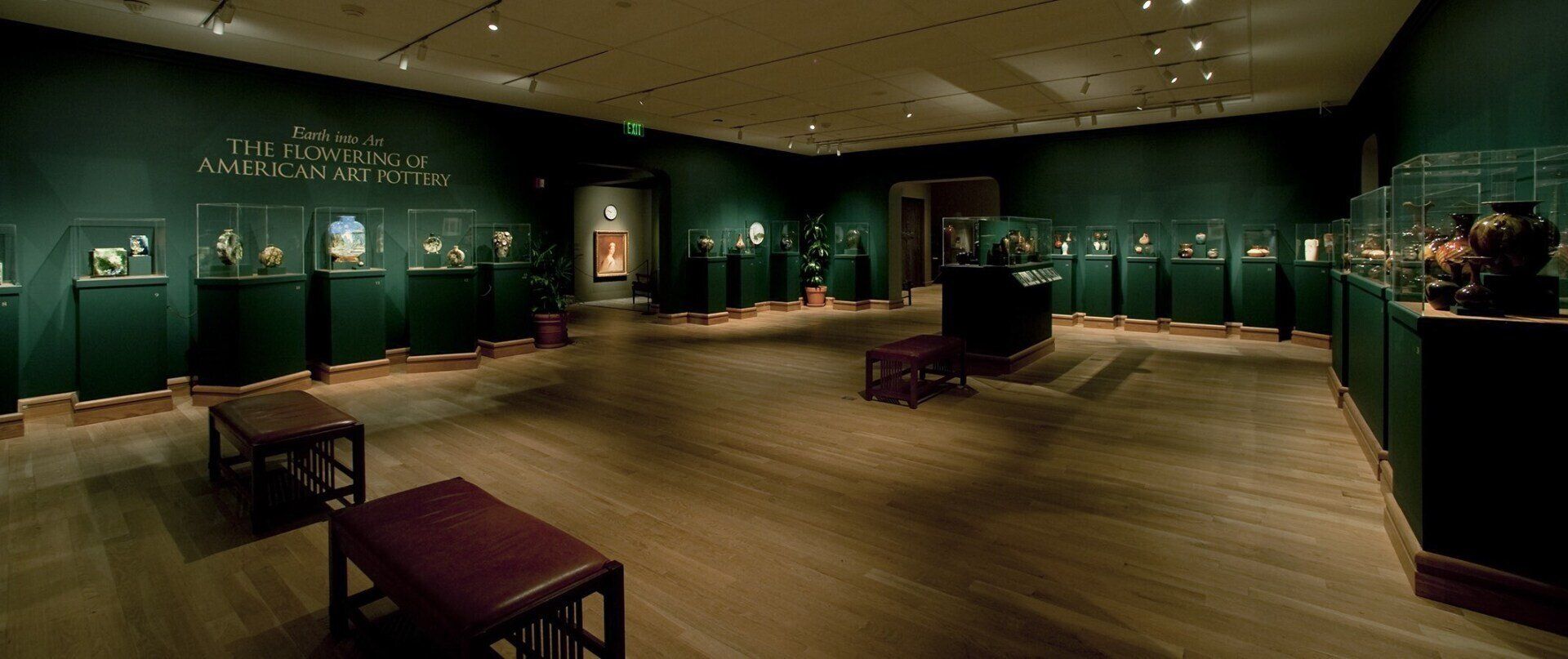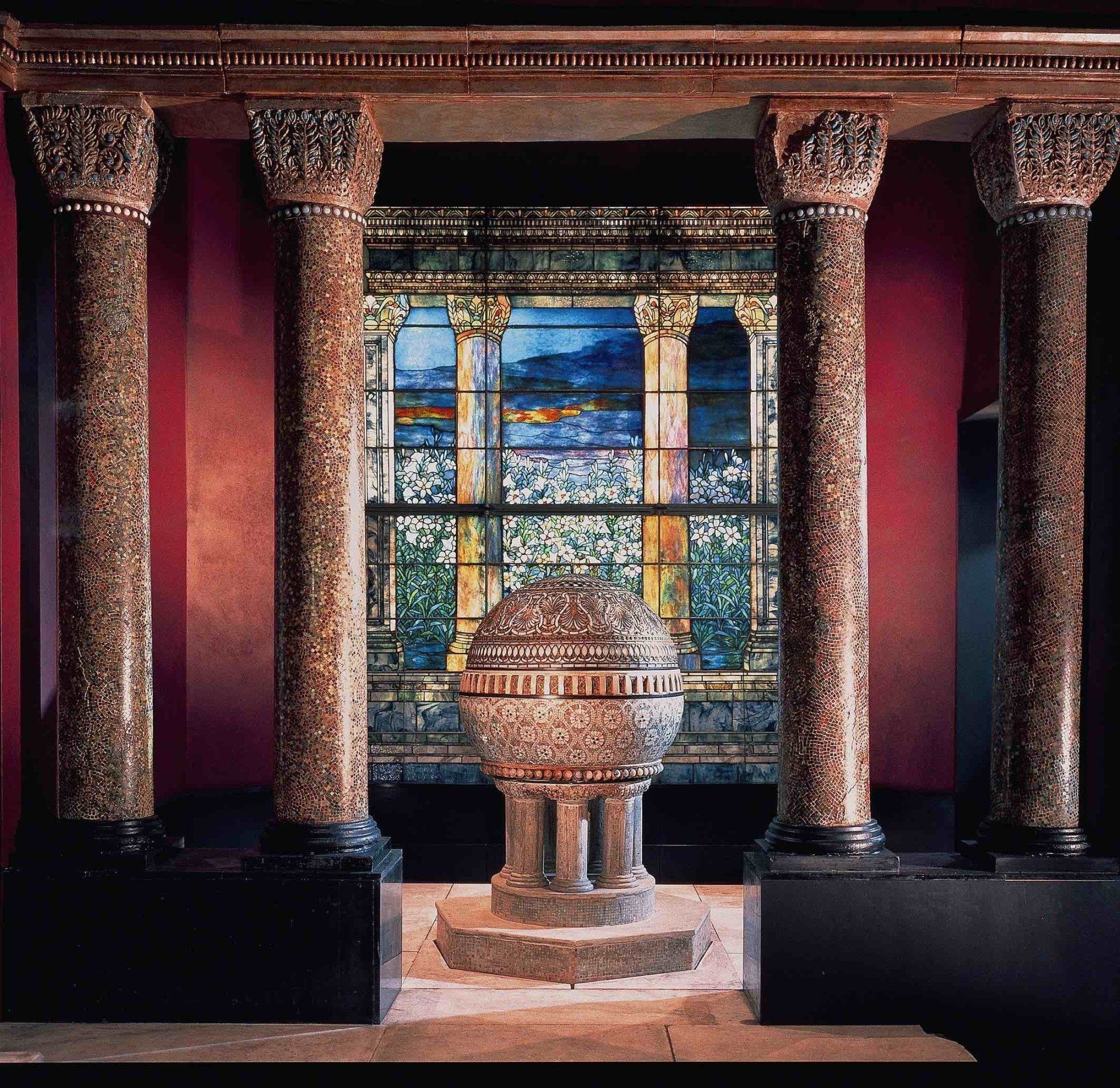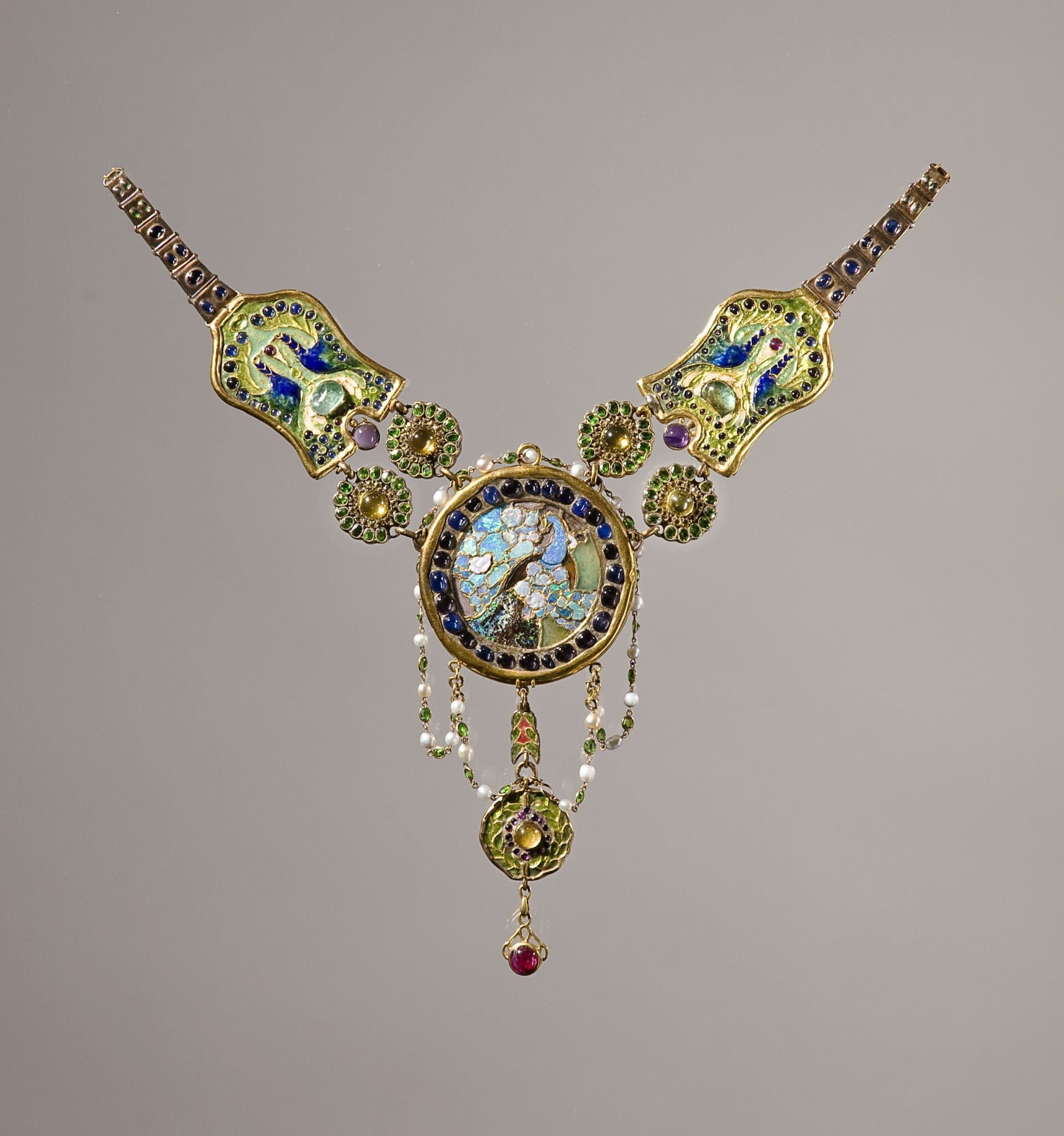THE CHARLES HOSMER MORSE MUSEUM OF AMERICAN ART
The Morse Museum houses the world's most extensive collection of works by Louis Comfort Tiffany (1848-1933), the legendary artist and designer, the interior of his chapel at the 1893 Chicago World's Fair, and art and architectural objects from his Long Island country estate, Laurelton Hall. The museum's holdings also include American pottery, American paintings, prints, and decorative arts of the late 19th and early 20th centuries.
The Morse Museum was founded by Jeannette Genius McKean (1909-1989) in 1942 and named for her grandfather, Chicago industrialist and Winter Park philanthropist Charles Hosmer Morse (1833-1921). The museum's collection was built over the half-century period led by Ms. McKean and her husband Hugh F. McKean (1908-1995), who held the post of museum director until his death.
The purpose of the museum's collection reflects the McKeans' interests, personalities, and ideals. The couple began their collection with objects already owned by their families, tracing their origins to the 1820s. In doing so, they built one of the most premier collections in American art.
In 1955, Jeannette McKean curated a first museum exhibition devoted exclusively to the work of Louis Comfort Tiffany. This exhibition arguably marked the return of the popularity of Tiffany's art, perhaps even surpassing the popularity of Tiffany in his own time.
In 1978, the McKeans donated the beautiful loggia from Tiffany's Long Island estate to the Metropolitan Museum in honor of Charles Hosmer Morse.
For 35 years, the museum was located on the Rollins College campus and was known as the Morse Gallery of Art. In 1977, it moved to 151 East Welbourne in Winter Park and was renamed The Charles Hosmer Morse Museum of American Art, where it opened on July 4, 1995. The Morse Museum is owned by the Charles Morse Foundation.
View of The Charles Hosmer Morse Museum of American Art from the corner of Canton and Park Avenues, Winter Park.
Photo by Raymond Martinot.
Courtesy of The Charles Hosmer Morse Museum of American Art,
Winter Park, FL.
THE MORSE COLLECTION
The heart of the museum is the work of Louis Comfort Tiffany (1848-1933). The museum's collection of Tiffany pieces is broad, deep and unique. The collection has rightly been called one of the most outstanding collections of Tiffany's work, as it covers every category in which he worked from every period of his life. Among the objects in the collection is the chapel interior and the largest collection from Tiffany's Long Island country estate. Here are pieces that Tiffany designed for his home, or chose to display there. Outstanding among these is the famous 1915 Daffodil Tarrace. The Morse Museum's collection also includes objects that distinguish Tiffany as a draftsman, decorator, architect, and photographer.
The Morse Museum is also a treasure trove of objects of American decorative art from the 19th to early 20th centuries. The Morse has a special interest in American Art Pottery collection, which now has over 800 patterns. The Arts and Crafts Collection also includes work by Gustav Stickley, the Roycrofters. Other artists include Thomas Crawford, Hiram Powers, Daniel CHester French, John Rogers and others.
Also on display are paintings by American artists such as Samuel F.B. Morse, a relative, and works by European artists such as William Morris. There are also glass, jewelry and metal artworks by Emile Gallé, René Lalique and Carl Fabergé.
TIFFANY CHAPEL
The Tiffany Chapel is one of the attractions of the Morse Museum. It is in the Byzantine-Romanesque style and was first erected for the 1893 Chicago World's Fair and later moved to the Cathedral of St. John the Divine in New York City. Tiffany reportedly said that "his chapel was a chapel in which to worship art"
In 1916, Tiffany reacquired the chapel and moved it to his home, Laurelton Hall in Laurel Hollow, Long Island, New York. After Tiffany's death, the Tiffany Foundation dismantled the chapel in 1949 and sold parts of it. The Foundation even expired the Anweseen and finally gave a serious fire in 1957.
Hugh McKean and Jeannette Genius McKean came to the destroyed estate and salvaged windows and architectural elements for the Morse Museum. They also tracked down previously sold portions of the chapel. After extensive renovation, the restored Tiffany Chapel opened to the public in 1999.
Tiffany Chapel Reredos, c. 1893
Laurelton Hall, Long Island, New York, 1902–57
Exhibited: World's Columbian Exposition,
Chicago, 1893 Glass mosaic
Tiffany Glass and Decorating Company,
New York City, 1892–1900 90 x 72 in.
DAFFODIL TERRACE
Tiffany's Daffodil Terrace was added to Laurelton Hall in 1915 or 1916 and was located adjacent to the dining room. It opened onto the surrounding gardens and parkland.
The terrace stands on eight slender columns of Carrara marble, with concrete capitals decorated with cast-glass daffodils. A pear tree in a central planter stretches skyward through an iridescent glass-lined square opening in the roof. The coffered ceiling in the three bays around the skylight is made of stenciled cedar, some of which Tiffany acquired in North Africa, and more than a hundred molded tiles with exotic geometric and floral motifs. These tiles, cast from a composite material of wood fibers and glue from Indian woodwork, are accurate to the wood grain patterns of the originals.
The design is quintessential Tiffany, embodying many of his life themes: the beauty of nature, his fondness for oriental decorative ideas, his almost stubborn preference for simple materials, his penchant for elegance and, above all, the combination of all this into a coherent whole of overwhelming aesthetic power.
Laurelton Hall Daffodil Terrace
Courtesy of The Charles Hosmer Morse Museum of American Art, Winter Park, FL.
Laurelton Hall Reception Hall
Courtesy of The Charles Hosmer Morse
Museum of American Art, Winter Park, FL.
Necklace, c. 1903–6
Exhibited: Salon of the Société des Artistes Français, Paris, 1905 or 1906
Peacock and flamingo - Enamel, opal, amethyst, ruby, sapphire, demantoid garnet, emerald, chrysoberyl, pearl, gold
Louis Comfort Tiffany, 1848–1933, designer -
Julia Munson [Sherman], 1875–1971, jeweler
Tiffany & Co., 1837–present, retailer 10 in. long (58-001)
Photo by Raymond Martinot
JEANNETTE GENIUS MCKEAN
Jeannette Genius McKean (1909-1989), the museum's founder was a gifted artist, interior designer, businesswoman, civic leader and philanthropist. Born in Chicago, she would settle in Winter Park. She grew to love the city, as did her grandfather, indutrialist Chales Hiosmer Morse, and carried on his tradition of philanthropy.
Jeannette grew up in Kenwood in the Rochardson-Romanesque style mansion that her grandfather had built and given to her mother as a birthday gift. The beautiful home was filled with art, as her artistic mother, Elizabeth Morse Genius bought American Impressionists, many of which hang in the Morse Collection today. Like many wealthy families of her time, her mother also collected Tiffany glass.
Jeannette attended private school in Chicago and later studied art in New York at the Grand Central School of Art. One of her teachers was the German painter Hans Hofman, who would influence her early work. She exhibited worldwide and also worked as an Interor designer in New York. She later developed a lifelong interest in Winter Park College and was elected to the Rollin College Board of Trustees in 1936 at the age of 27. In 1957, she established the Elizabeth Morse Genius Foundation. Jeannette Genius McKean was not only an artist but also a businesswoman and was posthumously honored by the State of Florida as one of the "Great Floridians."
As early as 1942, she had founded the Morse Gallery of Art and appointed Hugh F. McKean, then a Rollins Art Professor as its director. They married in 1945, and their 1955 exhibition, "Works of Art by Louis Comfort Tiffany," was to be the first major exhibition of Tiffany's work.
In 1957, the McKeans received word from one of Tiffany's daughters that his Long Island estate had burned. They decided to buy up everything that hadn't burned, and with that decision they established the largest Tiffany collection in the world.
HUGH F. MCKEAN
Hugh F. McKean was an artist, professor and art collector. He was president of Rollins Collge in Winter Park for 18 years and director of the Morse from its founding in 1942 until his death.
After studying at Rollins College, he headed the college's art department. As a young artist, he was selected by the Tiffany Foundation to work independently among other artists in Laurelton Hall. His experience had been so lasting that half a century later he was able to write about his memories in his book, The Lost Treasues of Louis Comfort Tiffany. He was named director of the Morse Gallery of Art by his wife in 1942. He was President of Rollins College from 1951 to 1969, Chancellor until 1973, and Chairman of the Rollins Board of Trustees from 1969 to 1973.
CHARLES HOSMER MORSE
Charles Hosmer Morse was the grandfather of Jeannette Genius McKean. He was managing partner of Fairbanks, Morse & Co, a concern that manufactured presses, trucks, railroad cars, motors and other machinery, and was instrumental in the dramatic industrial growth of America in the late 19th century.
The wealthy industrialist chose Winter Park not only for business investments but also as a private home. He gave Winter Park its first town hall, the country club, and subsequently land donations and other philanthropy.
NEWS AT THE MORSE MUSEUM
Another significant art collection has just been added to the Charles Hosmer Morse Museum of American Art, and it is the art collection of Theodore E. Stebbins Jr. and Susan Cragg Stebbins. Donated were 65 works of art and sculpture from the late 19th and early 20th centuries. Since the collection's beginnings in the 1960s, the Stebbins had continuously acquired works of art based on pure quality, whether a particular artist was famous or even completely unknown.
Gift from Theodore E. Stebbins Jr. and Susan Cragg Stebbins
Barnard Castle Thomas Moran
Courtesy of The Charles Hosmer Morse Museum of American Art, Winter Park, FL.
LAURELTON HALL IN LAUREL HOLLOW, LONG ISLAND, NEW YORK
The home of Louis Comfort Tiffany
TIME LINE OF THE MORSE MUSEUM
1942
- Morse founded.
Jeannette Genius founds the Morse Gallery of Art on the campus of Rollins College, naming it in memory of her grandfather, industrialist and philanthropist Charles Hosmer Morse. It opens on February 17 with art professor Hugh F. McKean as the first director.
1955 - Tiffany gallery exhibit.
Jeannette and Hugh McKean (married in 1945) organize Works of Art by Louis Comfort Tiffany, the first significant exhibition of the artist’s work since his death. The success of this exhibition sets the McKeans on the course that will make the Morse the world’s leading repository of the art of Louis Comfort Tiffany.
1957 - McKeans at Laurelton Hall.
The McKeans travel to Louis Comfort Tiffany’s burned Long Island estate, Laurelton Hall, and save all they can.
1976 - Morse Foundation established.
The McKeans create the Charles Hosmer Morse Foundation, which with additional funding from the Elizabeth Morse Genius Foundation established by Jeannette in memory of her mother, supports the Museum.
1978 - Galleries at Welbourne Avenue open.
On February 1, the Morse Gallery of Art opens to the public in a new home at 151 E. Welbourne Avenue in downtown Winter Park.
1980 - Hugh F. McKean‘s book
Hugh McKean’s book The ‘Lost’ Treasures of Louis Comfort Tiffany is published by Doubleday, advancing knowledge and appreciation of Tiffany on a national scale.
1987 - Name changed to Charles Hosmer Morse Museum of American Art
On May 20, the Morse Gallery of Art officially changes its name to The Charles Hosmer Morse Museum of American Art.
1995 - Morse opens at 445 North Park Ave., Winter Park, Florida location.
On July 4th, the Museum opens at its current location, 445 N. Park Avenue.
1999
- Tiffany Chapel addition opens.
In April, the Museum opens Louis Comfort Tiffany’s chapel interior from the 1893 World’s Columbian Exposition in a 4,300-square-foot expansion.
2011
- Morse opens new wing dedicated to Louis Comfort Tiffany‘s estate Laurelton Hall.
On February 19, the Museum opens a 12,000-square foot wing to provide the first permanent installation of surviving materials from Louis Comfort Tiffany’s Long Island estate, Laurelton Hall.
2017 - Morse Museum celebrates 75th anniversary.
In February 2021, the Morse celebrated its 75th anniversary, its legacy, and its continuing mission to make art a part of the lives of the people of its community.
The Charles Hosmer Morse Museum of American Art
445 North Park Avenue | Winter Park, FL 32789
www.morsemuseum.org
Texts ©Morse Museum
















